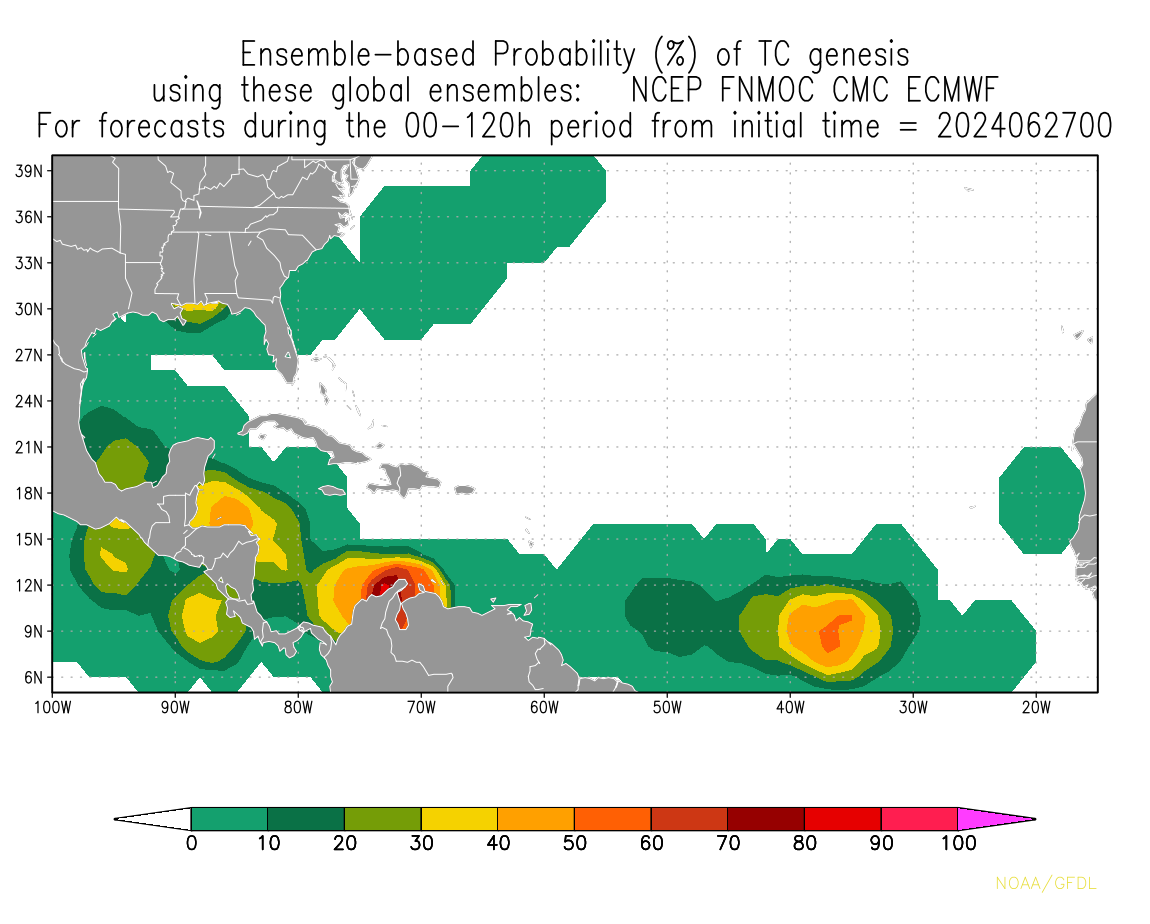Jacksonville, Fl. — The “Buresh Bottom Line”: Always be prepared!.....First Alert Hurricane Preparation Guide... City of Jacksonville Preparedness Guide... Georgia Hurricane Guide.
STAY INFORMED: Get the * FREE * First Alert Weather app
FREE NEWS UPDATES, ALERTS: Action News Jax app for Apple | For Android
WATCH “Preparing for the Storm”
WATCH “The Ins & Outs of Hurricane Season”
READ the First Alert Hurricane Center “Preparation Guide”
***** ALWAYS CHECK & RE-CHECK THE LATEST FORECAST & UPDATES! *****
REMEMBER WHEN A TROPICAL STORM OR HURRICANE IS APPROACHING: Taping windows is *not* recommended & will not keep glass from breaking. Instead close curtains & blinds.
Realize the forecast cone (”cone of uncertainty”) is the average forecast error over a given time - out to 5 days - & *does not* indicate the width of the storm &/or where damage might occur.
*** LOCAL (Jacksonville/NE Fl./SE Ga.) IMPACTS FROM THE TROPICS: None
The Atlantic Basin Overview:
(1) An active tropical wave - ‘94-L’ continues to move west/northwest across the Caribbean with an increase in t’storms but otherwise remaining disorganized. The wave has slowed some as it near the western ridge of the upper level ridge. Interaction with land likely limit this wave’s strength through a good part of the weekend but there will be heavy rain & potential flooding in Central American & the Yucatan Peninsula. The wave may have a window by early next week - as long as it’s far enough north - to organize once over the Bay of Campeche in the far SW Gulf of Mexico. No impacts to Jacksonville or any of Florida.
(2) A strong tropical wave - ‘95-L’ - that moved off the coast of Africa early this week is steadily moving west & has reached the Central Atlantic. Initially the mid & upper level air is dry & wind shear is pretty strong. But - as I point out often - the presence of Saharan dust & dry air does not necessarily simply equate to no tropical development. As is the case it would seem with this wave, the wave simply waits to organize once it’s out of the “dust cloud” which looks to be by late in the weekend/early next week. The GFS & European have trended similarly - a low latitude track through the Caribbean as the upper level high remains entrenched across the Lower 48 extending eastward across much of the Atlantic. Folks living in or traveling to the Caribbean should stay up to date on this developing situation. At this time, it appears there will be no impact to Florida.
(3) Another tropical wave is coming off the coast of Africa with at least some chance for development while moving west or W/NW across the Atlantic next week & beyond.
“Buresh Bottom Line”: The Caribbean wave - ‘94-L’ - will bring some heavy rain & gusty winds to Central America & Mexico. Time will tell as to whether or not the wave can survive the land interaction & then try to organize over the Bay of Campeche. The 2nd wave - ‘95-L’ - impacts the Caribbean next week. Stay up to date.....








The upper oceanic heat content (UOHC) [tropical cyclone heat potential/TCHP] across the SW Atlantic, Gulf & Caribbean is unseasonably high for this time of year:






Water vapor loop (dark blue/yellow is dry mid & upper level air):


June tropical cyclone origins (early season breeding grounds are the Gulf &/or Western Caribbean:
Averages below based on climatology for the Atlantic Basin for November (7 hurricanes so far, 19 tropical storms):

Wind shear (red - strong shear; green - low shear):





Saharan dust spreads west each year from Africa driven by the prevailing winds (from east to west over the Atlantic). Dry air = yellow/orange/red/pink. Widespread dust is indicative of dry air that *can* interfere with the development of tropical cyclones. However, sometimes “wanna’ be” waves will just wait until they get to the other side of - or away from - the dust plume then try to develop if other conditions are favorable. In my personal opinion, there is way too much “hoopla” about the presence of Saharan dust & how it relates to tropical cyclones. In any case, the peak of Saharan dust typically is in June & July.

2024 names..... “Beryl” is the first name on the Atlantic list (names are picked at random by the World Meteorological Organization... repeat every 6 years). Historic storms are retired [Florence & Michael in ’18 (the last time this year’s list was used)... Dorian in ’19 & Laura, Eta & Iota in ‘20, Ida in ‘21 & Fiona & Ian in ‘22]). In fact, this year’s list of names is rather infamous because of the ‘04 season when Charley, Frances, Jeanne & Ivan - all retired names - hit Florida within a matter of about 6 weeks. The WMO decided - beginning in 2021 - that the Greek alphabet will be no longer used & instead there will be a supplemental list of names if the first list is exhausted (has only happened three times - 2005, 2020 & 2021). The naming of tropical cyclones began on a consistent basis in 1953. More on the history of naming tropical cyclones * here *.





East Atlantic:





Mid & upper level wind shear (enemy of tropical cyclones) analysis (CIMMS). The red lines indicate strong shear:
Water vapor imagery (dark blue indicates dry air):

Deep oceanic heat content over the Gulf, Caribbean & deep tropical Atlantic. The colors will brighten greatly as the water warms to greater depths deeper into the season:

Sea surface temp. anomalies:


SE U.S. surface map:

Surface analysis centered on the tropical Atlantic:

Surface analysis of the Gulf:

Caribbean:

Atlantic Basin wave period forecast for 24, 48, 72 & 96 hours respectively:




East & Central Pacific:





West Pacific:

Global tropical activity:



Cox Media Group
:quality(70)/cloudfront-us-east-1.images.arcpublishing.com/cmg/JIFG55NSN5HKZK6LKEZ4C7UU5I.jpg)



:quality(70)/cloudfront-us-east-1.images.arcpublishing.com/cmg/SD5A6YPLEVGK5L5K6FXSROCC7U.jpg)
:quality(70)/d1hfln2sfez66z.cloudfront.net/06-29-2024/t_a3fd708266a5429cbc052af98dbcbdd7_name_file_960x540_1200_v3_1_.jpg)
:quality(70)/cloudfront-us-east-1.images.arcpublishing.com/cmg/KKMSQTUYCVDQDDSZBI7UO3XINE.jpg)
:quality(70)/d1hfln2sfez66z.cloudfront.net/06-30-2024/t_dcf0c02109e748a591292d69b826f7a1_name_file_960x540_1200_v3_1_.jpg)
:quality(70)/cloudfront-us-east-1.images.arcpublishing.com/cmg/K6PGNSTQCVE7XASP23GCEKGYVU.jpg)